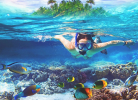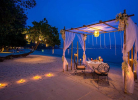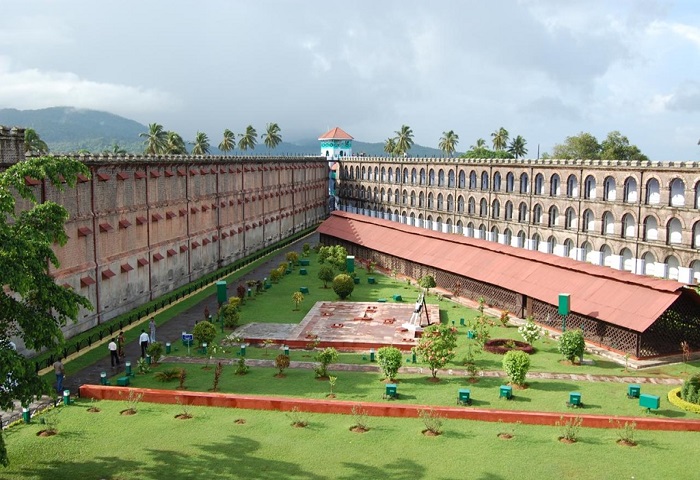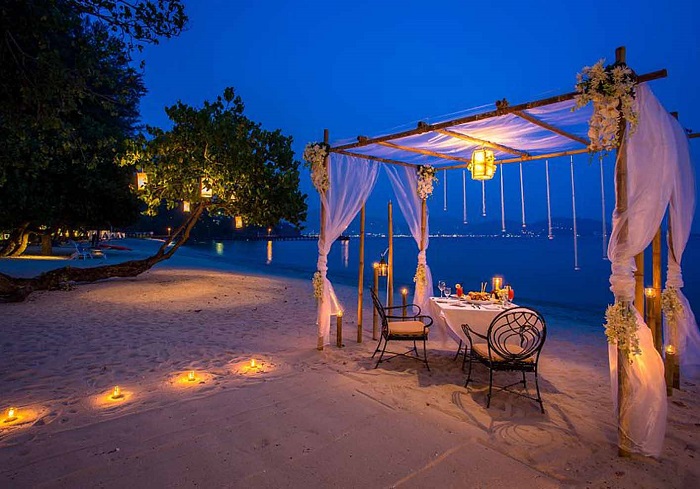Mahatma Gandhi Marine National Park, Andaman
Mahatma Gandhi Marine National Park is located in the South Andaman. The museum covers 281.5 square km in area. This national park covers 17 small islands on the Indian Ocean. It has open creeks scaling through the area. Tourists love to explore the park to enjoy ecotourism on Jolly Buoy Island and Red Skin Island. Most important islands of this park are the Red Skin Island and the Boat Island. Some of the islands in the park are very isolated and some are covered with thick foliage. Every year, tourists flock this national park to watch turtles and the Twin Islands are breeding grounds for the turtles.
History of Mahatma Gandhi Marine National Park
This park was established in May of 1983 for protecting the exotic marine lives like nesting sea turtles, corals, and others. The park was implemented under the forest department of Andaman and Nicobar group of Islands. The park is divided into two groups; the Twin Islands and Labyrinth Island. The park is currently protected by the Wildlife Act of 1972. Recently, the park became a strictly no-plastic zone to protect the exotic marine lives. Do you know that the park reassigns the snorkeling site, every six months to allow the coral life to regenerate?
Location of Mahatma Gandhi Marine National Park

The park is located closer to Wandoor of the South Andaman region. This group of islands is located 16 km away from the Port Blair, to its south.
Flora and Fauna of Mahatma Gandhi Marine National Park
The most important ecosystem of this park is the coral reefs. The most unique of the coral reefs found in this park is the Fringing Reefs. The vegetation and composition of the reef varies from one island to another. The Tarmugli Island, the largest island of the park holds mangrove forests lined along the beach.
The common fish species found in this park are scorpion fish, giant robber crab, angel fish, surgeon fish, butterfly fish, and grouper fish. You can find a few species of birds, and a large number of reptiles in this park. Top reptiles spotted in this park are pit viper, water monitor lizards, cobra, hawbills, krait, and a few species of crocodiles.
Top birds to spot here are parakeets, white-bellied sea eagle, red collared dove, Asian emerald dove, green imperial pigeon, lesser whistling duck, Andaman teal, Andaman wood pigeon, violet cuckoo, brown-backed needletail, and others. Staring from common myna to Eurasian curlew, there are more than 130 species of birds in this park.There are no terrestrial mammals in this park. You can find large marine animals like leatherback turtle, green turtle, Olive Ridley turtle, and others.
Tourist Attractions of Mahatma Gandhi Marine National Park
- Visit Twin Islands to watch turtles. If you visit during the right season, you can watch turtles hatching and walking towards the ocean
- Explore the thick vegetation and sheet rocks of Tarmugli Island
- Other attractions closer to the park are Chidiya Tapu, Viper Island, Corbyn’s Cove, Mackruzz, Lackadives, and others.
- Take part in the land and water activities in the park. There are secure changing rooms in the park.
Things to do in Mahatma Gandhi Marine National Park
- When it comes to human population, the park is completely unoccupied. However, you can find 10 small villages including Wandur and Manglutan closer to the park, where you can explore the indigenous lifestyle, culture, and cuisine.
- Stay back in the park until sunset to watch the sun setting from the beach. It is a romantic activity to enjoy.
- Enjoy snorkeling, free diving, scuba diving, or boating to explore the coral reefs of this park.
- If you are into land activities, you can enjoy trekking, camping, exploring, and others in various areas of the park.
- Jolly Buoy Island is also famous for birdwatching. If you are visiting in winter, you can spot interesting exotic migratory birds here.
- Ride on the glass-bottomed boat to watch the corals with ease
Entry Fee of Mahatma Gandhi Marine National Park
Permit is essential to reach the park. Every day, only 150 permits are allowed based on first-come, first-serve basis. If the demand is higher (during peak season) the number of permits might be increased.
- Camera permit: INR 25 per device
- Indians entry: INR 50 per head
- Foreigner entry: INR 500 per head
If you are carrying plastic bottles, you need to deposit INR 100 for three bottles. It would be refunded if you bring back the bottles without littering the place.
Visiting Timing of Mahatma Gandhi Marine National Park
The park is open from Monday to Sunday from 9 am to 3 pm.
Best Time to Visit Mahatma Gandhi Marine National Park
Boat services organized by the tourism departments will not be available on Mondays. However, you can find other private boats throughout the week. However, the private boats will be congested, if you are visiting on a Monday, during prime tourism season. November to February is the prime time to visit this park. This is the time when the climate will be pleasing and the visibility under the water will be very clear to spot numerous coral ecosystems. June to August is the worst time to visit the park. This is the monsoon season of the islands and the park will be closed.
Note : Make sure to visit the park as early as possible as only 150 people would be permitted into the park, every day.
How to Reach Mahatma Gandhi Marine National Park
You can reach the park by reaching Wandoor jetty from any part of the Andaman and Nicobar Islands. From Port Blair, you can find five boats specifically arranged for tourists to the national park. You can find a boat leaving the Port Blair jetty to Wandoor jetty for every 30 minutes, starting from 8:30 am to 10:30 am.
If you wish to enter the national park, you need to receive a permit. Based on the permit, you will receive a boat ride ticket for a specific time. Reach the jetty right on time to catch the specified boat. For your return journey, you can choose to ride any boat from Wandoor Jetty to Port Blair. Apart from these, you can find private boats from numerous jetties to Wandoor jetty.
Once you have reached Wandoor Jetty, you will find buses to the park organized by the government. You will find one bus for every thirty minutes from 6 am to 8 pm. Apart from the government buses; you can find private buses and cabs to reach the park.














